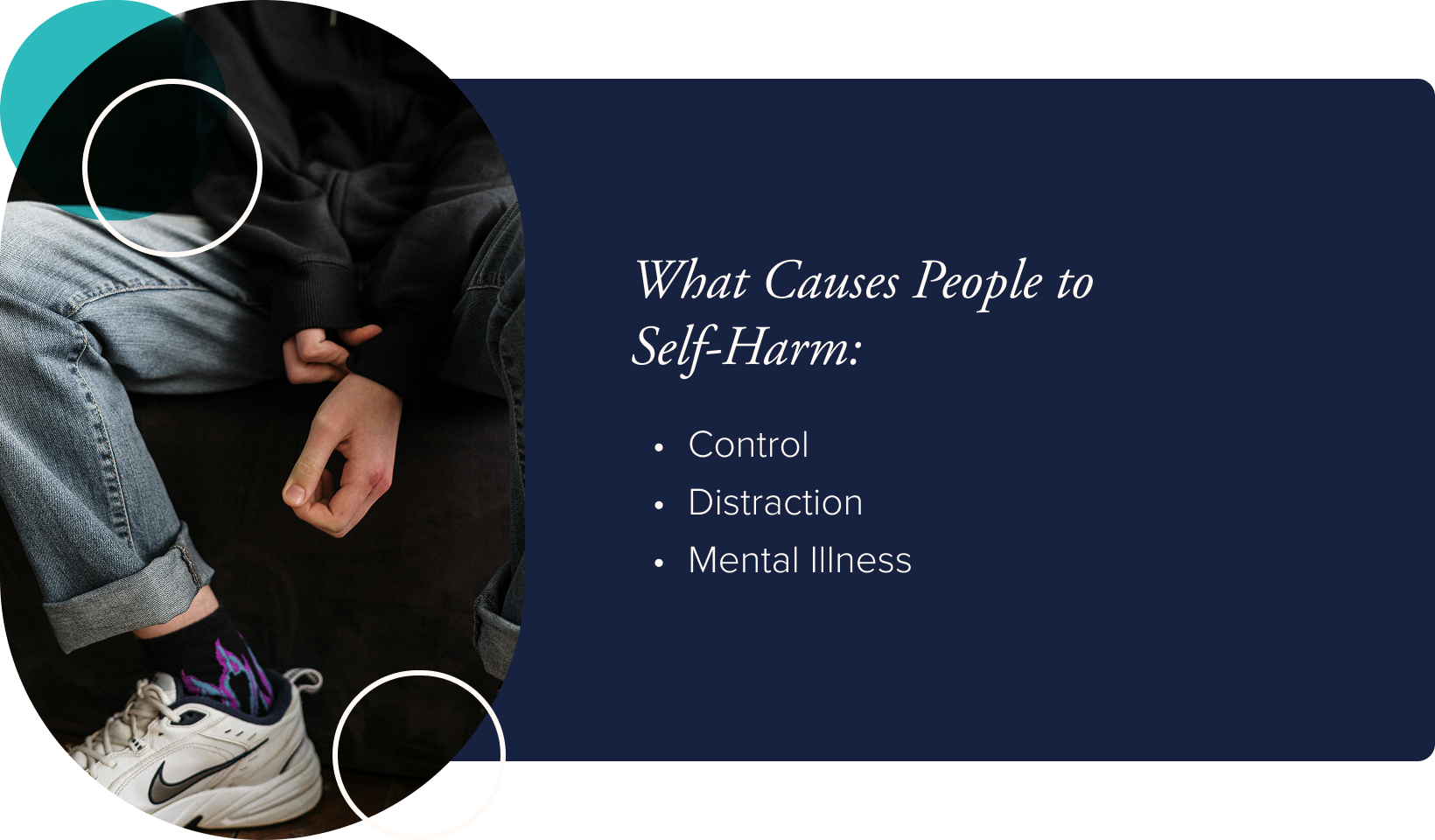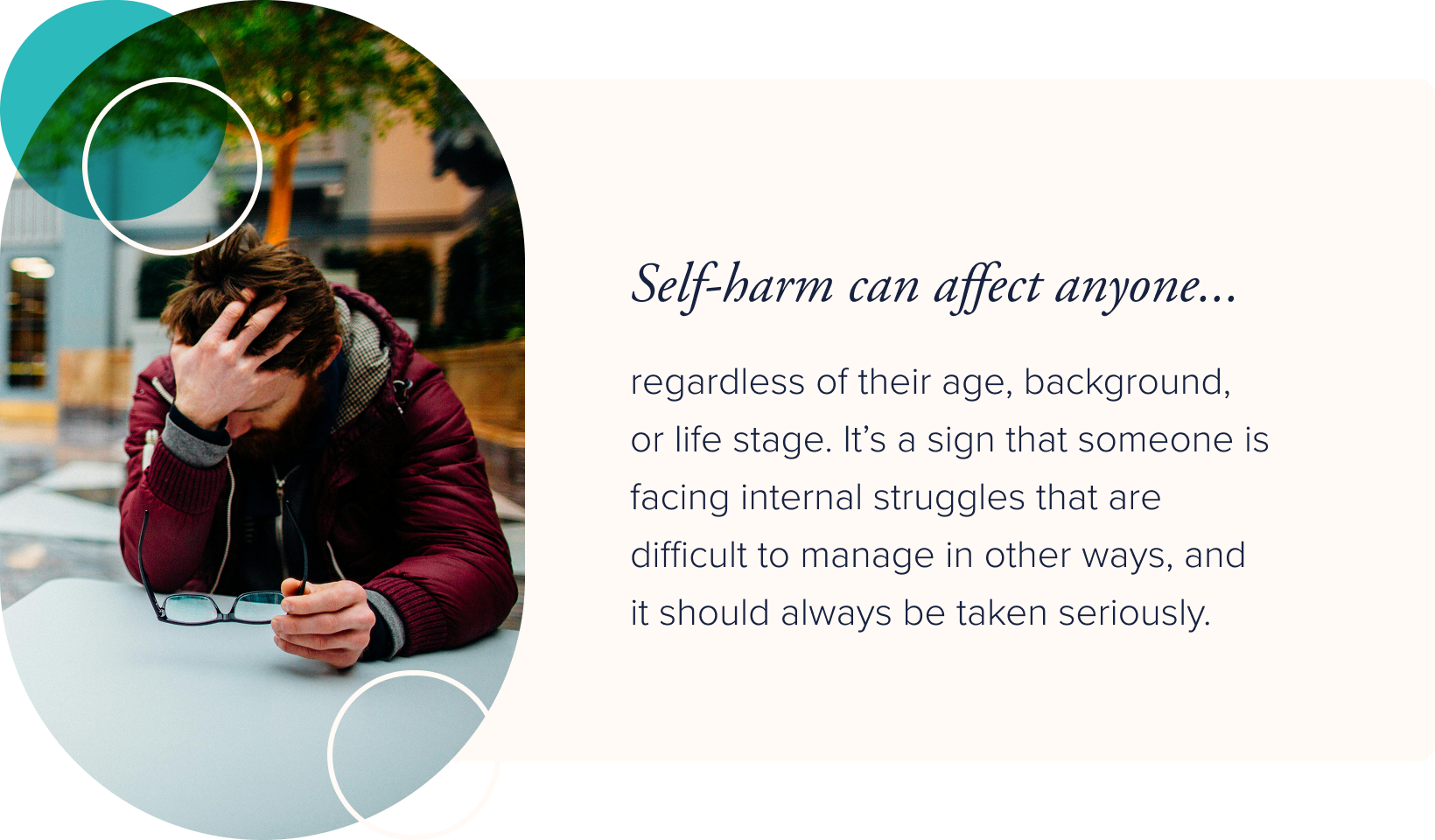
Self-Harm Relapse: How to Prevent It and What To Do if It Happens

One-on-One Counseling in Arizona for Life's Challenges
Every day is a chance to start over. Our trauma-informed therapists will meet you where you are — in person or online — so you can process your experiences and become the person you want to be.
Self-harm is clinically known as “non-suicidal self-injury” or more simply, “self-injury.” There are different types of self-harm, including cutting or scratching yourself with sharp objects, burning, or hitting yourself. But all approaches have the same objective of causing self-inflicted pain.
It’s a harmful habit, physically and mentally, but it can be treated alongside its causes. However, healing isn’t linear, and we may feel like we’ve stumbled backwards when it comes to dealing with our emotions and mental health.
What Causes People to Self-Harm?
While anyone of any age group can struggle with it, self-harm most commonly affects young people. Teenagers and people in their early 20s are often more at risk for self-harm because they’re still learning how to cope with intense emotions and overwhelming stress.
That being said, self-harm can affect anyone, regardless of their age, background, or life stage. It’s a sign that someone is facing internal struggles that are difficult to manage in other ways, and it should always be taken seriously.
To better understand these internal struggles, let’s take a look at the common reasons why people turn to self-harm.

Control
The root cause of someone's self-harming may vary from person to person. Some people self-harm as a way to feel control over their life and emotions when it feels like they have none otherwise.
Some people use self-harm almost as punishment because they feel they deserve it. They are “disciplining” themselves for actions or behaviors that they feel are wrong, or someone else has made them feel are wrong.
Distraction
Some people self-harm to distract themselves from intolerable emotions they may be feeling. Self-harm allows them to feel something different and distract themselves from those emotional pains that they don’t want to face.
Other people self-harm as a way of coping with trauma, neglect, or abuse. Again, it is often used as a coping mechanism for dealing with something happening now or something that has happened in the past.
The reasons for partaking in self-harm will vary person to person. Some cases will be more obvious than others, and some people may not even realize why they started self-harming in the first place.
Self-Harm and Mental Illness
While self-harm is not a mental illness itself, the two often go hand in hand. People struggling with certain mental health conditions are more likely to engage in self-harming behavior.
Self-harm is most often associated with borderline personality disorder, depression, anxiety, and PTSD. These conditions often result in incredibly strong emotions that are seen so often as the driving factor behind self-harm.

Read our related guide for an in-depth look at depression.
How Do Self-Harm Relapses Happen?
Self-harm gives a short-lived sense of euphoria and control, often followed by shame and guilt. These negative feelings that follow contribute to more engagement in self-harm. It is a negative shame spiral that becomes a cycle.
A spike in negative feelings or worsening mental health can drive the desire to self-harm. Someone may be at risk for relapsing if they hit a plateau or gentle backslide in their treatment. Again, this is normal and expected in mental health treatment, but it might be enough to cause a person to relapse with self-harm.
Unresolved trauma and new stressors that trigger old feelings can also trigger self-harming habits.
Self-harm creates a greater risk of suicide if help isn’t provided. Read our related article for more information on suicide and risk factors to look for.
Preventing a Self-Harm Relapse
No matter the reasons for self-harming, it is important to learn how to cope in other ways and avoid engaging in self-harm in the future. Even if you have struggled with self-harming in the past, you can be free of it going forward.
There is no “one-size-fits-all” fix that stops self-harming, but there are steps and strategies that help. It starts by finding healthier actions to take when you feel overwhelmed by the urge to hurt yourself.

Be Aware of Your Triggers
Once you know what causes the emotions that make you want to self-harm, you can learn to avoid those triggers or properly prepare yourself for when they do come. Keep track of what is going on and what you are feeling when these urges arise.
Read our related article to discover how to manage triggers.
TIPPs Skills
The TIPP method is a skill from dialectical behavior therapy (DBT). It consists of actionable steps to take when triggered (or anticipating a trigger) that helps people become more resilient to the effects of trauma or stress.
- Temperature—cooler temperatures can help keep you calm
- Intense exercise—getting your body moving so you can feel a dopamine rush and a sense of accomplishment
- Paced breathing—slowed, intentional breathing can make you feel calm and regulate emotions
- Progressive muscle relaxation—focus on relaxing your body, starting with the top of your head and progressing to your toes
Following these steps helps to keep people calm and focused on something other than any overwhelming, negative feelings and emotions. TIPP skills help ground you and connect your emotions and behaviors in a healthy way.
Replace Injurious Behaviors with Safer Options
When you feel the urge to self-harm, replace it with an alternative behavior. When you want to cut your arm, draw on it instead. Find peaceful behaviors you enjoy doing instead, like hiking or art.
Create a Support Network
Whether you are tempted to self-harm or someone you know is, support from others can help encourage them to fight the urge and engage in healthier coping mechanisms.
A friend, family member, or loved one can also participate in these healthy coping activities with you, or simply be a person to lean on when you need.
Read our related article to learn how to support a depressed spouse.
Coping with a Self-Harm Relapse
The goal is to avoid self-harm altogether, but often, relapses will happen. It is not easy to create long-lasting, sustainable changes in your behavior, and it may take a handful of tries before you get there. That is okay, and you are not alone in this.
Sometimes, you can go a period of time without self-harming and then be triggered into doing it again, So, what can you do once it has already happened?
Talk to Your Support Group
If you’ve relapsed, lean on that support network you have. Confide in someone you trust and feel comfortable with. It’s okay to ask for support or just a listening ear. They can help ground you, join in those healthy activities that you’ve learned to cope with self-harm temptations.
Talk to a Professional
Whether it’s your current therapist, previous therapist, or someone new, talking to a mental health professional who is trained in these situations will give you the best guidance and insight on what to do next.
Reaching out is a powerful step toward healing. With the right support, you can build the tools you need to cope with stress and intense emotions in a way that heals you, rather than harms you.

Compassionate Support When You Need It Most
At Inner Balance, you’re not just another client; you are a human with your own unique story and life. We want to make you feel safe and worthy, because you are.
If you battle with self-harm, we can provide the guidance and support you need to live the life you deserve. Our compassionate team has extensive training in DBT and the TIPPs method to guide you through even your most difficult struggles.
Reach out today to learn more about our program and start your journey to a healthier, happier life. We want to help you live the life you want, free of self-harm, and be here for support whenever life might get a little tough.
Related blog articles
Sign up for our newsletter
Sign up with your email address to receive news and updates.
Get started
Request a consultation

-03%201.png)




